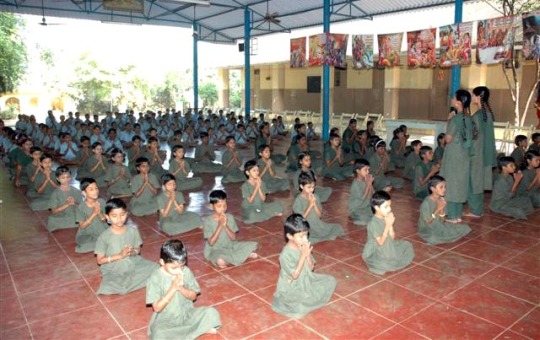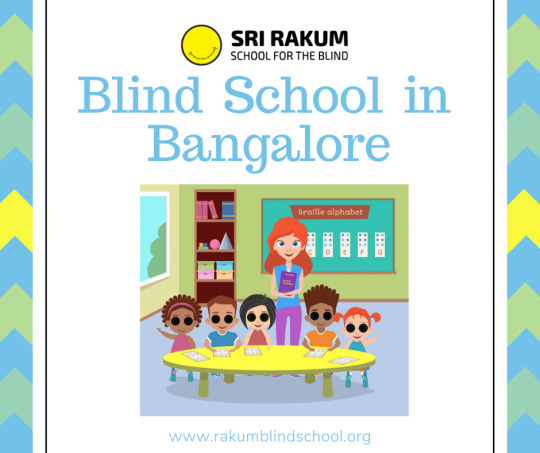#Orphanage in Arkavathi Layout
Explore tagged Tumblr posts
Link

Use positional and directional concepts like above/under, on top, behind/in front of, left/right etc. A charitable trust in Bangalore teaches students using visual concepts. Click here to know more https://rakum.org/
#Blind School in Bangalore#Blind Orphanage in Bangalore#Charitable Trust in Bangalore#Blind Organization in Bangalore#Non Profit Organization in Bangalore#Orphanage in Arkavathi Layout
0 notes
Text
The Challenges in Developing Interpersonal Skills for Visually Impaired Children

When it comes to the care and well-being of orphaned children, attachment is an important construct to consider. Not only may it help influence how an orphan child will integrate, or fail to, within the setting of a group foster care home, attachment patterns may also have a bearing in the nature of relationships they will have as an adult, after leaving the care of the home. Attachment is doubly important in the context of orphan children due to their histories of often having experienced loss or abandonment or witnessed significant trauma, including loss of loved ones. These factors have been described as leading to orphans having attachment challenges, with many being unnaturally avoidant or overly trusting. And yet, attachment theory as we know it is deeply rooted in a Euro-American understanding of child development. A blind school in Bangalore offers extra care for children to make them feel at home.
Specifically, attachment in the Western context is idealized and romanticized, built upon a pair-bond between one primary caregiver and one child. Due to difficult past histories and the realities of living in an institution, orphan children are considered to be a vulnerable population. Decades of research have suggested that orphan children, due to their circumstances, are more likely to demonstrate anxious or avoidant attachment. These attachment patterns, in turn, play a significant role in their development and in the formation of interpersonal relationships and are traditionally thought to stay semi-constant throughout an individual’s lifetime. Attachment theory concentrates on an infant’s bond with their caregiver when the infant is experiencing a negative state such as when they are hurt, separated from their caregiver, or perceiving a threat, as a template for future relationships.
This template is used to understand future relationships, and while attachment style can change throughout time, it is traditionally thought to be developed and refined in early infancy and childhood. This relationship has been thought to take on two different types: secure and insecure. Insecure attachment can be broken down into three subgroups: anxious, avoidant, and disorganized-disoriented. If attachment patterns are influenced by early childhood, it is easy to see how orphans are more likely to demonstrate anxious or avoidant attachment concerning any relationship they form thereafter being abandoned or given up in early childhood or infancy. A blind orphanage in Bangalore ensures a secure environment for children.
A residential care model is different from both a traditional orphanage system and a foster care system in that each home is typically smaller than the traditional orphanage (average number of children per home: twelve) with one to two caregivers at any given time, and a ‘mentor mother’ system. The mentor mother system was developed so that children in the program could meet and bond with highly respected and well-off women in their local communities. These women play the role of a mentor and push the children towards success. In Indian culture, for example, it is commonplace for children to be attached to multiple non-parental figures in a way that children in Western or European cultures may not. A Charitable trust in Bangalore ensures the children grow up in a caring environment.
#Orphanage in Arkavathi Layout#Blind Organization in Bangalore#Charitable Trust in Bangalore#Blind Orphanage in Bangalore#Blind School in Bangalore
0 notes
Text
The Importance of Professional Teaching for Visually Impaired Children

Many child care professionals still believe that orphanages are bad for children. Supposedly, young children fail to develop as they should, socially and psychologically. The prospective harm is even more certain if children are admitted as infants and remain for several years. Supposedly, this bad reputation is based on careful research, not Oliver Twist stories of gross maltreatment. Early in the 20th century, leaders in child care expressed the view that family care is preferable to orphanage care of needy children. This view seemed based on personal preference rather than a careful comparison of their relative merits. The available reports were mostly anecdotal or isolated case studies. A blind school in Bangalore employs qualified teachers.
By 1930, trained social workers helped place children in orphanages or foster care but they seldom evaluated general outcomes. Psychologists had already standardized ways to measure individual intelligence or social maturity but these tools were seldom used outside of schools and clinics. Some clinical psychologists and psychiatrists evaluated selected orphanage children on an individual basis. But this did not constitute evaluations of orphanage programs as such. One important exception is the large scale survey conducted about 1929. Clinical psychologists were used to comparing individual intelligence for several thousand orphaned children and home-raised children and they got comparable results. However, the former showed greater gains in body weight than the home-raised children. No study of this magnitude has been conducted since that time. A blind orphanage in Bangalore arranges periodic checkups for children.
Psychological theories about child development and ways to handle children had only a slight, indirect bearing on orphanage practice. For example, so-called Behaviorists during the 1920s studied the emotional development of children. Their limited findings encouraged regular, somewhat rigid, eating and sleeping schedules. No systematic studies on the validity of these teachings were conducted in the orphanage setting. Freudian theories had some impact on child-rearing methods after the 1930s when child-centered theories became popular. Psychiatrists with Freudian views recommended self-demand schedules, plus liberal weaning and toilet training methods. The aim was to prevent frustration, which might cause neurotic habits. Again, these suggestions were derived mostly from case studies of adult neurotics rather than the systematic study of orphanage youth.
A bleak view of orphanage care developed within professional child care ranks. It was based more on selected clinical studies than on systematic evaluations or comparisons. In brief, it claimed: -- Any amount of orphanage experience is harmful. The damage is greatest during the first years of life and increases dramatically with the length of stay in an institution. Besides being irreversible, the resulting damage affects a wide range of psychological and social traits.
Since the concept of "maternal deprivation" is central to arguments against orphanage care, it deserves careful study. Its theoretical importance stems, of course, from basic assumptions about the needs of developing children. All of us agree that growing children need strong, interactive relationships with responsible adults. Besides giving emotional and physical security, such ties help the child grow and learn to cope with an ever-changing world. In most societies, the child's parents are considered the optimal social arrangement for child care and mothers are expected to play the central role. A charitable trust in Bangalore receives huge donations from doners.
#Blind School in Bangalore#Blind Orphanage in Bangalore#Charitable Trust in Bangalore#Blind Organization in Bangalore#Non Profit Organization in Bangalore#Orphanage in Arkavathi Layout
0 notes
Text
Charitable Trust in Bangalore

In order to ensure an engaging classroom session while teaching visually impaired children, encourage them to clap in order to ask questions. In a traditional classroom, a student raises their hand in order to ask questions during a lesson. A charitable trust in Bangalore helps in replacing visual cues with audio cues.
#Blind School in Bangalore#Blind Orphanage in Bangalore#Charitable Trust in Bangalore#Blind Organization in Bangalore#Orphanage in Arkavathi Layout
0 notes
Text
How Volunteering and Donations Support Charitable Organizations?

Volunteering plays a prominent role in the charitable provision of goods and services, yet we know relatively little about why individuals spend time and money to the charity. Assuming that volunteering is a consumption good, we analyze the determinants of individuals’ charitable cash donations and volunteer labor as well as the interdependence between both goods. The hypothesis that time and money donations are gross complements, however, is not supported by analysis, as evidence suggests that individuals substitute time donations by money donations as the price of time raises. Analyzing philanthropic behavior on a disaggregated level reveals large differences in the determinants and the relationship of time and money donations – both across different types of voluntary organizations and across different welfare regimes. A charitable trust in Bangalore accepts both money and voluntary services from individuals.
Volunteering is often regarded as being fundamental to the sustainability of civil society. In order for non-profit organizations to exist and to be effective, individuals who voluntarily contribute to these organizations are required. The literature on why people participate in voluntary organizations is rich. Researchers from several disciplines, including social scientists, psychologists, political scientists, and economists, have tried to understand the volunteering phenomenon. Most of these studies have focused on the explanation of voluntary labor supply while the supply of charitable contributions of money is widely disregarded. These analyses ignore that there are two ways of contributing to the charity – spending time or spending money – and that the decision on which way of charitable contribution to choose is not independent of each other.
Understanding the interdependence between voluntary labor supply and charitable donations, however, is important for policies intending to increase the support of non-profit organizations. If, for example, charitable contributions of time and money represent gross substitutes, policies aiming for an increase in voluntary labor supply will result in a reduction of revenues from donations. Using an individual’s net wage as the price of voluntary labor supply and one minus an individual’s marginal tax rate as the price of money donations, they find a negative price and cross-price elasticities for volunteer labor. Their results indicate that charitable gifts of time and money are gross complements.
Furthermore, most existing studies treat charitable behavior as a homogeneous commodity and do not allow the determinants of volunteering, as well as the relationship between contributions of time and money, to vary by the type of voluntary organization. This issue is addressed via estimating and comparing volunteer labor supply in three sectors that rely on voluntary labor: health, education, and religious organizations. As a matter of fact, the vast majority of existing studies on voluntary labor as well as money donations concentrates on a single country. Empirical evidence for other countries as well as cross-country comparisons with respect to the determinants of time and money donations are missing in the literature. Those researchers that have been interested in understanding cross-national aspects of philanthropic behavior have focused their attention on explaining voluntary labor supply, while charitable cash donations are disregarded. A blind organization in Bangalore accepts charity from all over the country for their endeavors.
#Orphanage in Arkavathi Layout#Non Profit Organization in Bangalore#Blind Organization in Bangalore#Charitable Trust in Bangalore#Blind Orphanage in Bangalore
0 notes
Text
Blind School in Bangalore- Sri Rakum

Want to be a part of soul pleasing good deeds? Contact Sri Rakum Blind school in Bangalore and give them a hand in creating a better world for visually impaired children. Your small contribution could help them accommodate more children who need help.
#Non Profit Organization in Bangalore#Orphanage in Arkavathi Layout#Blind School in Bangalore#Blind Orphanage in Bangalore#Charitable Trust in Bangalore
0 notes
Text
The Importance of Inculcating Non-verbal Communication in Children with Visual Impairment

Blind children produced gestures, although not in all of the contexts in which sighted children gestured, and the gestures they produced resembled those of sighted children in both form and content. Results suggest that gesture may serve a function for the speaker that is independent of its impact on the listener. When people talk, they gesture. With movements of their hands, speakers indicate size, shape, direction, and distance, lend emphasis to particular words and highlight essential phrases. Gestures have been observed in children before they can talk. Because gesture is less codified than speech and has the potential to convey information via image. The meanings not easily encoded into speech can be conveyed in the accompanying gestural stream. As a result, the gesture can convey information that is not explicitly encoded in speech. A blind school in Bangalore trains children to communicate effectively via body language.
It provides a unique window into the mind of these observations suggest that gesture can play an important role in communicative situations. The gesture is attended to by listeners and can substantially affect the message that the listener abstracts from the communicative act. When adults were asked to listen to a narrative in which gesture and speech were deliberately manipulated to convey different information, they attempted to reconcile the discrepancy between the two modalities in their retelling of the story. When adults were asked to observe a series of children explaining their responses to a Piagetian conservation task, they incorporated information that the children conveyed only in gesture into their verbal assessments of the children’s reasoning about the task.
Thus, the information conveyed in gesture is accessible to listeners and is frequently incorporated into the message that a listener takes from a situation. Gesture, in other words, often plays a communicative role for the listener. In order to tease apart the communicative role that gesture plays for the listener from any role it might play for the speaker, We must examine gesture production in individuals who have had no experience whatsoever with the communicative value of gesture. Individuals who have been blind from birth are an ideal population in which to explore this question because they have never seen gesture produced in communication situations and thus have no first-hand knowledge of the ways in which gesture can enhance a��spoken utterance.
If these individuals gesture despite their lack of experience with the communicative uses of gesture, we will have evidence that gesturing is an essential part of speaking—an act that speakers perform for themselves as well as for their listeners. Despite the fact that the blind population is of great potential importance to researchers seeking to explore the functions of gesture, very few investigators have examined gesture use in individuals who have been blind from birth. With respect to mature speakers, only two studies have made any systematic attempt to determine whether blind adults gesture spontaneously and to describe the form that such gestures might take. The nonverbal behaviors produced by a small group of adults blind from birth were analyzed in an informal conversational situation using the typology of nonverbal behavior. A blind orphanage in Bangalore involves children in continuous conversations.
#Blind School in Bangalore#Blind Orphanage in Bangalore#Charitable Trust in Bangalore#Blind Organization in Bangalore#Non Profit Organization in Bangalore#Orphanage in Arkavathi Layout
0 notes
Link

By making your contributions to them, you can help them improve the life of a lot of visually impaired students. To know more about them, visit http://rakumblindschool.org.
#Blind School in Bangalore#Blind Orphanage in Bangalore#Charitable Trust in Bangalore#Blind Organization in Bangalore#Non Profit Organization in Bangalore#Orphanage in Arkavathi Layout
0 notes